Updated January 2021
For most of us, video chat apps used to be just a small part of life. A call to your aunt in Germany via webcam, perhaps, or a business conference with foreign investors. Maybe you used it as a way to make new friends and meet new people.
But as we all know by now, we’re in a bit of a serious video chat renaissance. Video conferencing is now a major part of our personal and professional lives and will be forever more. The things we want from our video chat and voice call apps have changed.
For businesses, in particular, video conferencing may be the principal—if not the sole—communication tool being used for geographically dispersed team collaboration. Luckily, the world of video calling applications has been steadily growing for some time now. Today, consumers and businesses alike have plenty of options at their disposal.
Take RingCentral’s very own video conferencing app, Glip®.
Glip is a prime example of new-age video communications. Why? Because Glip goes beyond the bare minimum to provide users with an all-in-one collaboration tool for business teams. From unlimited team messaging and video meetings, to task management, file sharing, and so much more, Glip is paving the way for the future of team collaboration. (But we’ll get more into that later.)
So, which video calling app is the best?
The answer is: that depends on your unique criteria. But don’t worry. We’ve done some of the heavy lifting for you. Read on to learn more about:

Our checklist includes all the essential features to look for…and even some that might surprise you!
Business vs pleasure: How does this influence which app you should choose?
Before choosing a free video chat app for your team, it’s important to know what you’re after. Let’s talk business versus pleasure for a moment.
Not all video apps are made with business communications in mind. So first things first, it’s time to narrow down your list a bit.
Longstanding consumer apps like WhatsApp, FaceTime, and Facebook Messenger may be modern-day staples within your social network, but they lack the necessary features for effective business team communications.
As for the new kids on the block. Marco Polo might be fantastic for video messaging, Houseparty might host the best game nights, and Duo might be awesome for family meetups, but keep these apps for the weekend.
They’re just not great substitutes for custom-made business communications solutions. Security (which is a biggie) aside, if you want to be able to do other things beyond just a video chat (like sharing files and linking your meetings to your Google Calendar), you have to look at more business-focused apps.
So let’s hone in on the best business apps for video chatting. What essential ingredients go into making awesome remote team collaboration tools like the ones in the list below?
What to look for in a business video chat app
Whether you’re looking for a pure video conferencing app or a broader team collaboration tool, the top 10 list below will give you some strong options to consider.
But right now, let’s get to the heart of the matter and ask: what should I be looking for?
When choosing a team collaboration application, we’d suggest prioritizing these key features:
There are some great free business tools on the market. But free tools aren’t always best, and great tools aren’t always expensive! The best way generally is to start with one of the many free apps or free trials out there—then consider upgrading to a paid plan if and when necessary.
For instance, Glip by RingCentral has a completely free plan and offers everything a small business needs to get up and running with professional team messaging and video meetings. (And then you can upgrade if you want—you can check out the plans and pricing here).
Not everybody using the new app will be a tech whizz, so choose something that’s easy to use! For us, we’d prioritize clear dashboards, displays, and navigation tools.
If you’re conducting business meetings online, then you’re likely also sharing confidential information in those meetings. Any video chat or communication tool should have robust security features to protect you against cyberattacks (and avoid any unwanted professional, financial, or legal implications).
- The “extra oomph” features
Look for an app with lots of features beyond a basic video call. If you choose wisely, you might be able to streamline the number of tools your team is using (and paying for)—go for versatile apps that do multiple things well, like file sharing, team messaging, and task management. This will save you from having to source different apps for those jobs.
(For example, Glip lets you go from messaging to a video meeting in a click, and has tons of other useful features such as recording, file sharing, calendar integrations, and more.)
Choose an app that is scalable. You may only need to conduct small-scale meetings to start with, but you’ll want some room to grow. Make sure that your chosen application can support a sufficient number of participants. Most services have a free option that can be scaled up with a paid plan at a later date.
The top 10 free team video chat apps
By this point, you should have a pretty good idea of your business and team needs. So, let’s go straight into our top 10 business-focused video chatting apps.
1. Glip by RingCentral
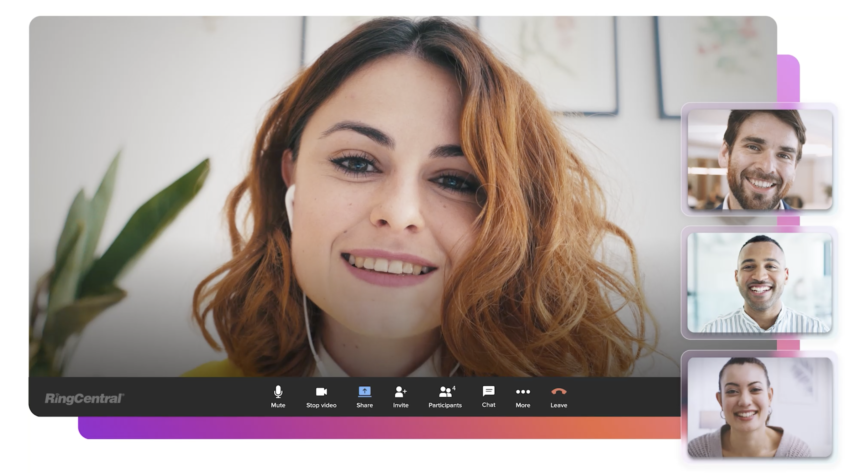
First things first, Glip is very different from the likes of WhatsApp and FaceTime, in that Glip is specifically designed to meet the needs of businesses.
And the other big thing that we’ll just get out of the way now: Glip doesn’t have a meeting time limit. Not all meetings can be wrapped up in 40 or 50 minutes, which is why Glip lets you have meetings for up to 24 hours at a time.
(We sincerely hope your meetings don’t go that long.)
Beyond unlimited video conferencing, Glip also has built-in team messaging:
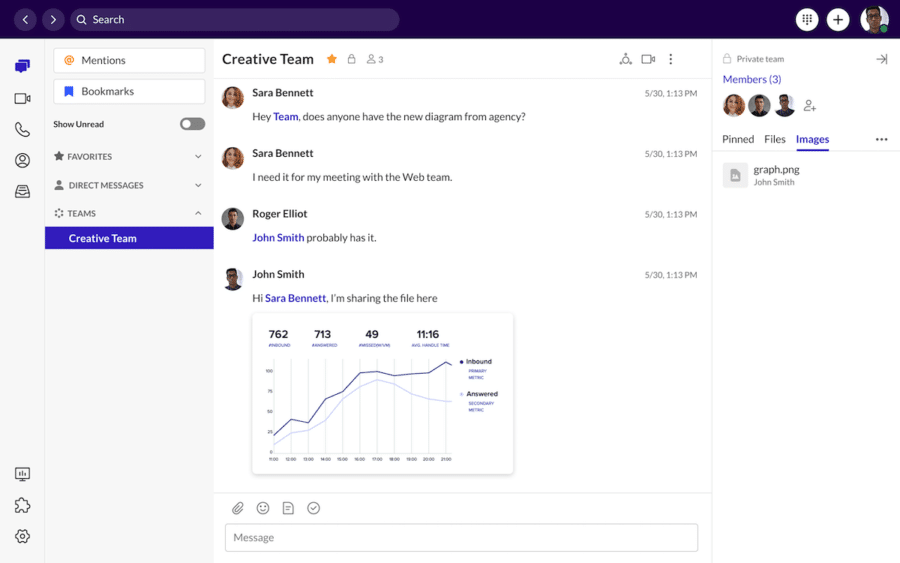
And even task management!
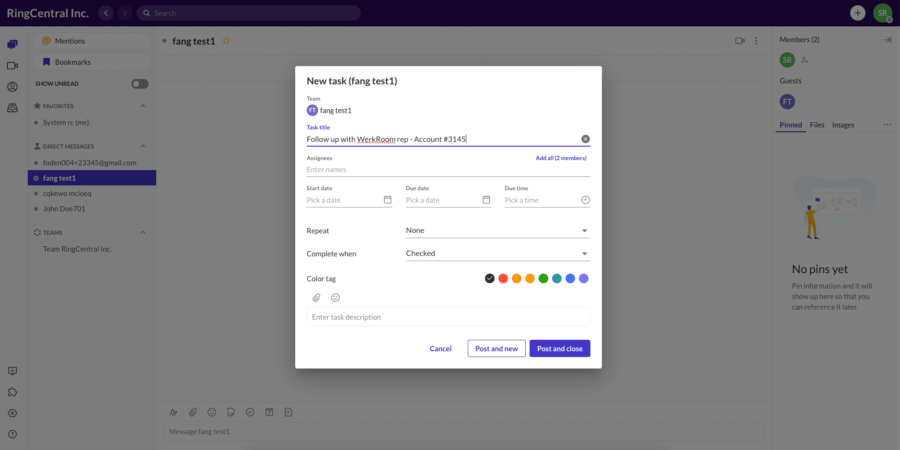
The app isn’t just free, it’s secure too. That makes it ideal for freelancers, intra-office team communications, customer support, and much, much more. Glip is designed to bring distributed teams together through multiple communication channels, making it easy to work from anywhere in the world.
Oh, and if you’re looking for scalability, then look no further. If you need more than what Glip’s free plan gives you, you can upgrade to its big cousin, Glip Pro+, at any time.
With the free Glip Pro plan, you get:
- Lightning-speed setup (seriously, it takes a few seconds)
- Video meetings for up to 24 hours at a time—no 40-minute limits!
- File sharing
- Task management
- Screen sharing
- File annotation
- In-meeting private and group chats
- Video recording
- Integrations with your favorite email, CRM, and apps
- A handy desktop and mobile app
- RingCentral’s seven layers of security
Want even more security upgrades? Glip Pro+ gives you all of this, plus more advanced features like Single Sign-on, analytics, and a business phone service.
The take-home: Okay, we’re a little biased, but take a look at the other options—we think Glip compares really well to any other free app out there. It’s truly designed to be the ideal business solution for fast-growing businesses in need of flexible ways to communicate with teammates, prospects, customers, and more.

 Free unlimited video meetings. Really.
Free unlimited video meetings. Really.Get started
2. Skype
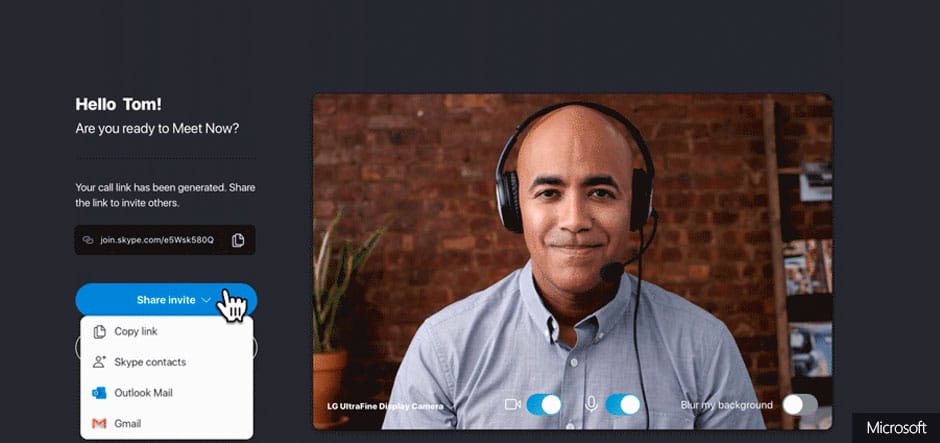
Skype is a household name around the world. Most of us think of Skype as the go-to video calling platform. (Although the competition is, well and truly, creeping in.)
Skype’s main goal in recent years has been to try to bridge the gap between business and pleasure. Available on iOS, Android, Windows, and Mac, the app is equally well-suited to personal calls as it is to business communications—well, almost.
Skype is sometimes prone to technical disruptions like freezing—which can be annoying during a personal chat, but a deal breaker in a business meeting.
Skype users get features like:
- Up to 50 callers
- No call time limit
- Record, save, and share video calls
- Live captions and subtitles
- “Meet Now” feature
- Blurred backgrounds
- Presentation sharing
3. Microsoft Teams
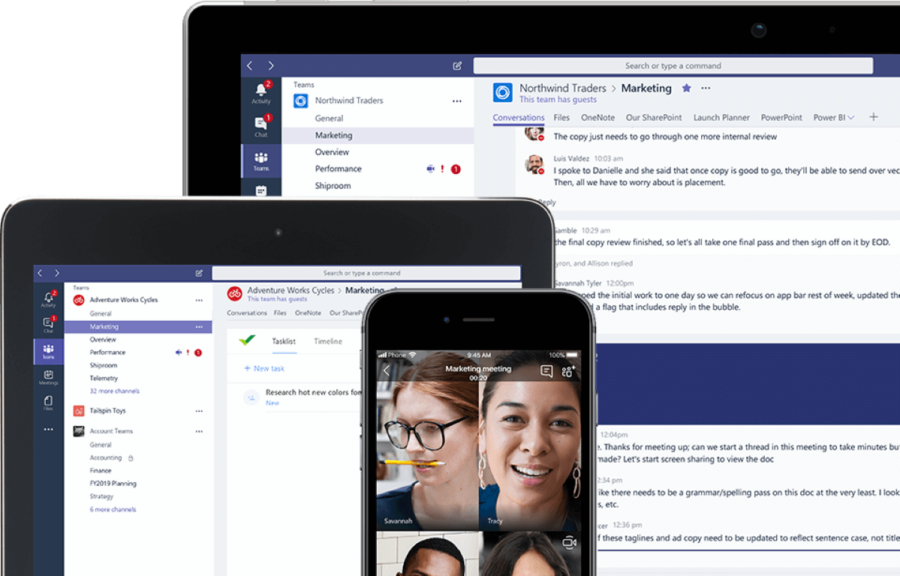
If your company’s already heavy into Microsoft products, then it makes sense to use Microsoft Teams for video chatting. After all, it lives in the same product family as apps like Word, Excel, and Powerpoint.
Teams combines messaging, video meetings, and audio calling capabilities with Office tools for an all-in-one streamlined office experience. Create groups of up to 20 people and share files and screens for an “in-office” experience from anywhere.
But Teams falls short when it comes to ease of use. Despite the Microsoft 365 integration, it can be difficult to transition from Outlook, file structures are sometimes confusing, and the online meeting experience is itself a little clunky.
4. Jitsi Meet

Jitsi Meet is a relatively new name in town. This free, multi-platform, open-source app is designed with real-time video conferencing in mind. Jitsi clients can use the multi-user conferencing tool—or build their own to their unique specifications. (Ah, the benefits of open source tools.)
Jitsi Meet works on iOS, Android, web, React-native, and Electron apps. It’s reasonably easy to use the preset client, but some users have reported setup headaches due to the numerous external components. (The downside of open source is that you have to be a bit techy to get an app to work just the way you want it to.)
Jitsi Meet features include:
- Up to 75 participants
- The option to build your own via Jitsi video bridge
- Lots of app integrations
- The ability to “kick out” participants
- Public and private chat options
- Background blurring
5. Google Meet
Formerly Google Hangouts Meet, Google Meet is the latest evolution of Google’s video conferencing platform.
Google Meet is a Google Workspace platform that supports team meetings via a simple web link. This is especially handy for those organizations that already use Workspace, as it allows users to link directly to Google Calendars.
There’s no need to download a desktop application as everything happens via web browser, making this a simple (though less sophisticated) video conferencing option.
But this simplicity is also Meet’s downfall.
You can only access Meet via browser, and only Chrome at that. On the other hand, with Glip, you can switch between different devices while you’re on a meeting seamlessly:

Google Meet users get:
- Up to 100 participants
- Noise cancellation feature
- Built-in Google Calendar scheduling
- Admit/deny entry
- Available to all Gmail users
- Mobile device compatibility
- On-the-go meetings
- Integrations with Google Workspace
- Anti-hijacking controls
- Telephony dial-ins
- Meeting codes
6. Amazon Chime
As per usual, Amazon has a finger in every pie. Video conferencing is no exception. Amazon Chime allows users to communicate both inside and outside of their organization in the same app.
You can place business calls, schedule video meetings, or simply text chat—though it’s pay-per-use—on a platform that ranges from the free basic tool to various high-spec features.
But Amazon Chime lacks many of the built-in features you get with Glip and some other video conferencing tools. For example, there’s no open API, multi-language support, or whiteboarding here.
7. Zoom
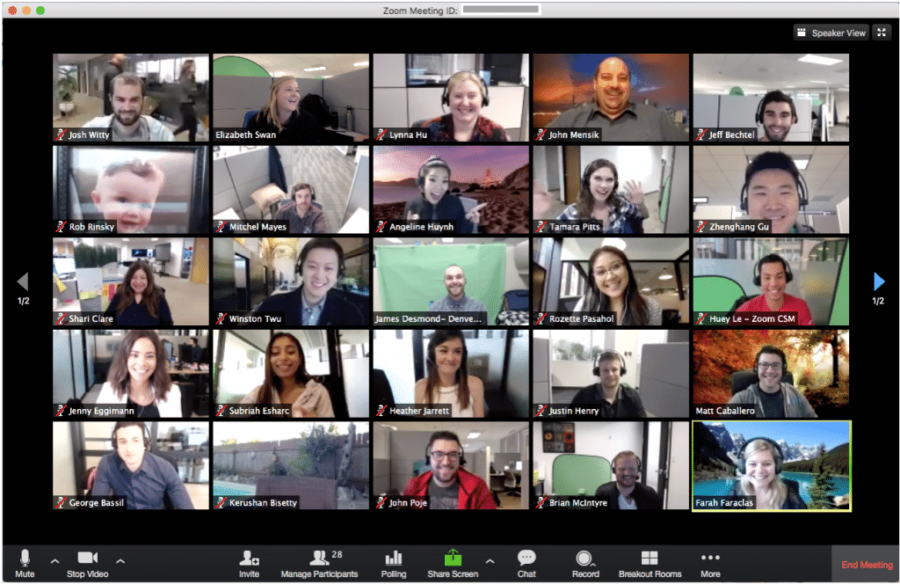
One of 2020’s biggest hits, Zoom has gone from zero to hero pretty darn quick and is now one of the most well-known video conferencing apps available on the market.
This is in large part due to its simple usability and navigation. Zoom is another highly versatile app that used to be a very popular tool for personal use, that’s now trying to expand into the business arena.
The free client offers a few key features:
- Up to 100 participants
- Unlimited 1:1 meetings
- Suitable for Windows, Apple MacOs, Android, and iPhone/iPad
Unfortunately, Zoom’s free client limits group meetings to 40 minutes.1 If lengthy team discussions are what you’re after, you will love Glip’s unlimited meetings on any of your favorite devices.
8. Cisco Webex
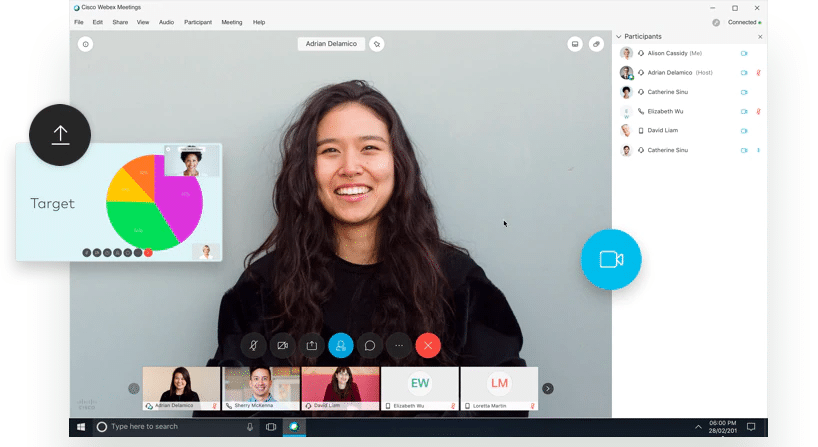
Webex is an oldie but goldie. This video conferencing application was first brought to market in the 1990s, before being acquired by Cisco in 2007.
Webex is primarily targeted at the business market, so it’s great for office team meetings and remote communications.
Features include:
- Up to 100 participants
- Record and save meetings
The downside? Once again, meetings are limited, this time to 50 minutes2.
9. StarLeaf

StarLeaf is a business video conferencing tool that’s been around for a while, but don’t be too surprised if this is the first time you’re hearing about it. You won’t find StarLeaf on any of the usual price comparison websites. That’s because StarLeaf is specifically targeted at large businesses and organizations.
StarLeaf has opened its doors further due to the COVID-19 pandemic though, and is offering a free client that contains all the basic video and messaging features.
Key tools included in the free plan:
- Up to 20 participants
- Up to 45-minute meetings
- Unlimited 1:1 meetings
- Phone number dialing from 50+ locations
StarLeaf is a great starter option, but if you’re looking for top-notch presentation tools and HD audio, you might be left disappointed. For HD meetings, noise reduction, recording, and more, go with Glip.
10. Whereby
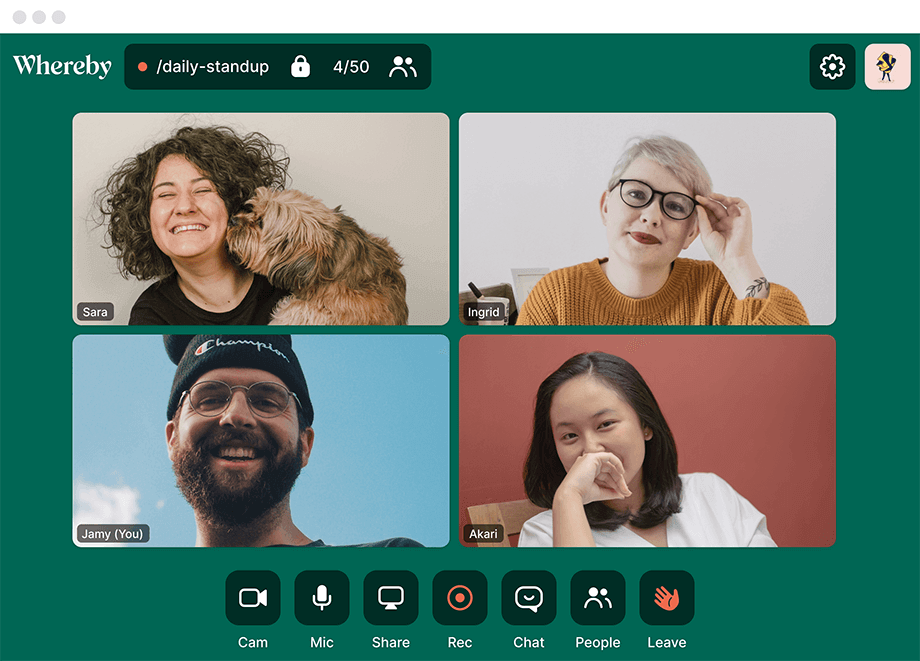
The free plan offered by Whereby is a great option from small businesses, sole traders, and freelancers in need of a simple video application solution.
You’ll get access to priority customer support even under the free plan. Create custom meeting URLs and lock chat rooms for added security with end-to-end encryption.
Whereby’s video chat app gives you:
- Up to 50 participants
- File storage and sharing
- Screen sharing
- YouTube integration
- Lock rooms
- Custom URL
- Chat function
- The ability to mute/eject users
- Emojis
Despite these great features, Whereby can’t be downloaded onto a computer (Windows or Mac) and can only be accessed via web browser or a mobile device.
Whilst this is great for flexibility, it may not suit permanent team infrastructures. For a comprehensive, all-around, solution that works on any device, Glip is the answer.
Which is the free video chat and calling app for your team?
You’ve had the RingCentral lowdown on all things video conferencing. Now it’s over to you.
Which free app is going to take your business communications to the next level?
1zoom.us/pricing
2webex.com/pricing/index.html
Looking For Startup Consultants ?
Call Pursho @ 0731-6725516
Telegram Group One Must Follow :
For Startups: https://t.me/daily_business_reads







